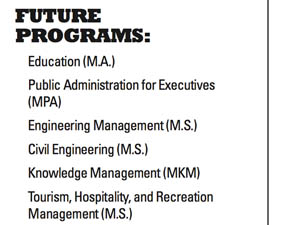
Technology has become an increasingly used component at CSUN whether it be an online teaching tool or equipment inside the classroom to enhance learning.
CSUN is gearing towards students being able to receive their degrees solely online according to a recent report by the department of Academic Technology entitled, “CSUN in the Digital World,” which examines the future of teaching and the role faculty plays.
According to the report, CSUN currently has six fully online degree programs and eight programs in development scheduled to launch in the next 18 to 24 months.
Interim Director of Academic Technology Deone Zell believes this new initiative caters directly to the changing learning styles of students.
“Technology changes so fast so the future is hard to foresee. However, it is clear that students want more mobility and multimedia (videos) in their learning,” Zell said.
Hiring for the future
Moodle has been one of the staples of CSUN’s push for innovative teaching, which is a free open-source web application that the administration adopted in 2009 in order to make online learning and teaching easier.
Dr. Penelope Jennings, associate vice president of faculty affairs, said that although Moodle has not replaced any teaching jobs on campus, there has been an increase of faculty teaching online and hybrid courses.
Mika Williamson, associate director of Recruitment Services and Compensation for the Office of Human Resources, said the Infomation Technology (IT) department has made 130 new hires since 2003.
Williamson said roughly half of these hirings are centralized in IT and are responsible for delivering effective technology infrastructure around campus. The other half are decentralized, which means they are working with faculty, computer labs and assisting students with online troubleshooting.
According to Associate Vice President of Academic Resources Diane Stephens, newly hired faculty are expected to be familiar with changes in technology. Although it is not specific in the job description, it is almost necessary to perform the job successfully.
“Faculty are hired for their expertise in their disciplines and this often includes specific expertise in technology-enhanced instruction,” Stephens said. “Faculty are not displaced by technology, but their reach is sometimes extended by technology.”
According to Zell, faculty can receive training through the Faculty Technology Center which is funded jointly by the departments of Information Technology (IT) and Academic Affairs.
Zell added that faculty do not need to know how to use Moodle prior to teaching an online class because of the vast resources available to them like quick guides, video workshops, and one-on-one support for faculty.
“(Faculty) are trained by instructional designers and fellow faculty who receive release time to assist their peers,” Zell said. “Faculty can also watch a variety of video tutorials on Moodle and other instructional technologies through Lynda.com. If there is a learning curve, it can be scaled quickly.”

Paying for progress
Over the past couple of years, instructional designers and video editors have been hired in order to assist faculty with the new and emerging technologies on our campus. The funding for this also comes from the Academic Affairs department with supplementation from the IT department.
Instructional designers are professionals, usually with with master’s degrees, and their salaries range from $59,592 to $63,312 with funding coming from Academic Affairs and IT.
Stephens explains where the funds come from for these new programs.
“The campus redeploys funds among varying priorities over time. This includes accommodating new programs and changes in technology,” Stephens said.
As for technology inside the classroom, Stephens states that there is a separate budget for classroom technology and improvements that is not equated into the budget for online learning resources.
The fully online programs are offered using self-support funding, which is run out of extended education and doesn’t come from the general pool of state funding. This will pay faculty as well as the eLearning team that will provide production services, instructional design support, technical support, faculty training/development, and student orientation.
A member of the CSUN eLearning team would be assigned to each faculty in developing course material.
Student convenience
Although CSUN has not been able to quantify financial savings from this enhanced technology, Stephens said the campus has become more user-friendly and efficient as a result.
Zell echoed those sentiments and believes that the increase in technology has helped the university in two ways.
“Technology tools such as Moodle, Lecture Capture and eTexts save money and can improve student outcomes,” Zell said. “It provides learning materials digitally and on-demand so that students can access them anytime and anywhere, to fit in with their increasingly mobile lives.”
Lecture Capture, which is a technology that allows instructors to record their lectures inside or outside the classroom, gives students a chance to rewind the instructor and that gives students an infinite number of opportunities to watch the lecture and increase comprehension of the material.
Moodle and Lecture Capture don’t save money for the university but add functionality and improve teaching and learning by creating a space where students can access the system at any time.
CSUN President Dianne F. Harrison has also pushed for a more technologically oriented campus with her iPad initiative. Her goal is to incorporate the iPad and other educational tools into the classroom and for faculty to use iBooks Author to generate low-cost, efficient e-books at a lower cost for students.

